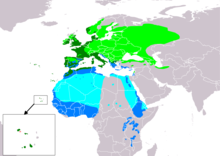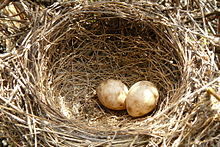Blackcap
| Blackcap | ||||||||||||
|---|---|---|---|---|---|---|---|---|---|---|---|---|

Blackcap ( Sylvia atricapilla ), singing black-capped |
||||||||||||
| Systematics | ||||||||||||
|
||||||||||||
| Scientific name | ||||||||||||
| Sylvia atricapilla | ||||||||||||
| ( Linnaeus , 1758) |
The blackcap ( Sylvia atricapilla ) is a songbird belonging to the warbler genus . It is the most common warbler in Central Europe .
description
The blackcap is 13.5 to 15 centimeters long and has a wingspan of 20 to 23 centimeters. It weighs between 15 and 22 grams.
The top is dark gray, the bottom is olive gray. The throat and the under tail-coverts are light, the iris always black. The tail is always dark, lighter at the base and without white. The flanks are slightly brownish, more pronounced in females and young birds than in males. The beak and legs are gray.
The black feather cap is characteristic of the males. The scientific species name "atricapilla" (Latin "black head") and the popular name "Schwarzplattl", which is common in Austria and Bavaria, refer to it. The females and the young birds have a red-brown cap. Males in the first winter have a brown, black, or mixed cap.
voice
Typical singing begins with a quietly babbling verse and then suddenly increases in volume. These short stanzas, consisting of fluting tones, sound “overflowing”. Every now and then sounds similar to noises and sometimes imitations of other birds are inserted into these. The song is performed long and persistently at the beginning of the courtship , especially after returning from the wintering area, and decreases as the breeding season increases. From mid-July onwards it can only be heard rarely.
The motifs of the song are learned from the male young birds and are thus passed on. You sing for the first time in autumn, this autumn chant has shorter verses. Due to the large distribution area of the blackcap, a number of dialects have developed, which means that local differences can be observed in the song. The loud flap in singing can also occur regionally as a simplified form, the so-called lyres.
In addition to the singing, you can often hear a smacking excitement sound like "tak" or "tek", which reminds of pebbles hitting each other and is repeated several times in quick succession. Also in quicker succession as “dededede” or “täg täg täg…”. The warning call is a rough “rree” or “schräit”. The call to locate the young birds that have flown out is a very typical “idat” that can also be heard from the adult birds in the breeding area from April to September. This is often the only utterance in the wintering area in the Mediterranean .
Distribution area and habitat
The blackcap is common in all of Europe with the exception of Iceland , northern Scandinavia and the northernmost tips of the British Isles . In the south, the limit of distribution lies in northwest Africa and the Black Sea . In the east the distribution extends to the Western Sayan and the Caspian Sea .
In Central Europe the blackcap is widespread almost everywhere, with the exception of areas without trees or bushes and in the high mountains from around 1500 meters altitude, with the highest densities in alluvial forests , damp mixed forests and shady parks. Treeless shrub stands are avoided. Outside of the breeding season, it usually stays in bushes that bear a lot of berries, then also in open countryside. In the wintering area it is very versatile in its choice of habitat. The blackcap also breeds in the middle of large cities in bush-rich and tree-lined gardens and parks. In the selection of the breeding ground, the blackcap is the most versatile warbler in Central Europe. Partially shaded areas are preferred in front of dry, open and sunny areas. It prefers hardwoods over coniferous forests, but can also occur locally more in evergreen vegetation such as ivy or laurel forests .
Migratory behavior
The blackcaps that breed in Northern and Eastern Europe are medium and long-distance migrants , in Western and Central Europe they are short and medium-range migrants, and those that breed in the Mediterranean area are partial migrants . The blackcap breeding on the Atlantic islands (Canary Islands, Madeira and Cape Verde) show no migratory behavior.
The wintering areas depend on the migration distance and range from the coast of the Atlantic in western and southern Europe to South Africa . A growing number of individuals are already overwintering in Central Europe.
Since the 1960s, parts of the southern German and Austrian population have embarked on a more north-westerly migratory route that leads them to Great Britain . In addition to climatic changes, this is mainly attributed to bird feeding that is widespread in the UK. Since the more north-westerly migrating individuals have begun to differ from the main population in terms of beak shape, wing shape and color, it is assumed that a new (sub) species is emerging here.
food
The food consists of insects and their larvae and spiders during the breeding season . Berries and fruits are an important part of the diet from summer to March, unlike the other warblers. The young are also fed with it. In spring nectar and stamens, for example from almond blossoms, are also used; After returning from the winter quarters in adverse weather conditions for insect flight and the presence of mistletoe, also the sticky outer part of mistletoe berries without the seeds. This makes them one of the few species of mistletoe-spreading birds in Europe.
Reproduction
The blackcap builds its nest low in dense bushes, as a half-open bowl made of grass, moss and roots. The clutch usually consists of five eggs that are incubated for 10 to 15 days. The young birds leave the nest after 10 to 14 days.
Systematics
There are five subspecies , which, however, hardly differ morphologically .
- S. a. atricapilla Linnaeus 1758, the nominate form , occurs in Europe north of the Mediterranean
- S. a. dammholzi Stresemann in 1928, comes in the Caucasus to the north iran ago
- S. a. pauluccii Arrigoni 1902, occurs in the central and eastern Mediterranean
- S. a. heineken Jardine in 1830, comes to Madeira , the Canary Islands , in the south of the Iberian Peninsula and in north Africa before
- S. a. gularis Alexander in 1898, comes to the Cape Verde Islands and the Azores before
Existence and endangerment
The total population of the blackcap in Europe is 25 to 49 million breeding pairs, with a slightly increasing trend. Locally, the inventory can fluctuate by more than 50 percent. Lately, there has been an increasing number of population increases and, in some cases, area extensions in Germany and Austria. In Germany in 2008 the blackcap was regarded as the eighth most common breeding bird species with 2.6 to 3.3 million breeding pairs. The blackcap is not considered endangered.
swell
literature
- H.-G. Bauer, E. Bezzel, W. Fiedler : Passeriformes - Sperlingsvögel. 2nd Edition. Aula, Wiebelsheim 2005, ISBN 3-89104-648-0 ( The Compendium of Birds in Central Europe. Volume 2).
- L. Svensson, PJ Grant, K. Mullarney, D. Zetterström: The new cosmos bird guide. Franckh-Kosmos, Stuttgart 1999, ISBN 3-440-07720-9 .
Individual evidence
- ^ Ward JM Hagemeijer, Michael J. Blair: The EBCC Atlas of European Breeding Birds. Their Distribution and Abundance. Poyser, London 1997, ISBN 0-85661-091-7 .
- ↑ As observed by Peter Berthold , among others , see Knut Janßen: Bird migration against the rules of nature? In: Berliner Zeitung. May 28, 1998.
- ↑ Peter Berthold et al.: Rapid microevolution of migratory behavior in a wild bird species. In: Nature. 360, 1992, pp. 668-670 ( doi : 10.1038 / 360668a0 ).
- ^ Gregor Rolshausen et al .: Contemporary Evolution of Reproductive Isolation and Phenotypic Divergence in Sympatry along a Migratory Divide. In: Current Biology. 19, No. 24, December 3, 2009, pp. 2097-2101 ( doi : 10.1016 / j.cub.2009.10.061 ).
- ↑ Jessica von Ahn: How tit dumplings change evolution. In: Wissenschaft.de. December 4, 2009, accessed September 9, 2019 . (Report on the research work of G. Rolshausen et al.).
- ↑ R. Gnielka: Data on the breeding biology of the blackcap ( Sylvia atricapilla ) from the Halle district. In: Contributions to ornithology. 33, 1987, pp. 103-113.
- ^ G. Heine, G. Lang: Changes in the number of birds in the Fetzach-Taufachmoos between 1974 and 1987. In: Communications from the Conservation Working Group in Wangen im Allgäu. 4, 1988, pp. 6-29.
- ↑ Christoph Sudfeldt among others: Birds in Germany. 2008. (PDF; 8.4 MB) Umbrella Association of German Avifaunists, Münster 2008, page 7.
Web links
- Sylvia atricapilla in the endangered Red List species the IUCN 2009. Posted by: BirdLife International, 2009. Retrieved on 4 December of 2009.
- Videos, photos and sound recordings of Sylvia atricapilla in the Internet Bird Collection
- Singing blackcap on vogelstimmen-wehr.de
- Age and gender determination (PDF; 4.9 MB) by Javier Blasco-Zumeta and Gerd-Michael Heinze (English)
- Blackcap singing
- Blackcap feathers





